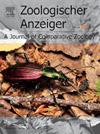重新审视茧蜂属(膜翅目:茧蜂科):一个迟来的分类更新
IF 1.5
3区 生物学
Q2 ZOOLOGY
引用次数: 0
摘要
Pompilidae是一群黄蜂,俗称蜘蛛猎手,因为它们的行为是捕捉蜘蛛以发育它们的幼虫。许多新热带属缺乏广泛的研究和分类关键,例如Priocnemella Banks。该属最近在分类组成上发生了变化,这是一个形态和系统发育相关的属。Eragenia接收了一些来自Priocnemella的物种,而Phanochilus Banks则与Priocnemella同义。尽管提出了这些变化,但该群体从未在分类上进行过修订。由于缺乏更新的钥匙和插图,物种鉴定受到阻碍。本研究旨在回顾Priocnemella属,研究两性的外部形态和雄性生殖器形态。Priocnemella aurata (Fox, 1897)的地位得到了重新确认;Banks, 1946和Priocnemella eurytheme (Banks, 1944)与P. hexona (Fox, 1897)同义。讨论了Priocnemella dimidiaticornis (Spinola, 1851),首次对其雄性进行了描述和图解。已知有十种Priocnemella: Priocnemella fairchildi (Banks, 1925), Priocnemella fuscomarginata (Fox, 1897), Priocnemella hexagona (Banks, 1925), Priocnemella gloriosa (Smith, 1873), Priocnemella aurata (Fox, 1897) status rev., Priocnemella aurodecorata (Cameron, 1912), Priocnemella nobilitata (Smith, 1866), Priocnemella ornata (Banks, 1946);Priocnemella insignis (Banks, 1946)和Priocnemella dimidiaticornis (Spinola, 1851)。我们的结果强调了进一步的分类学研究以提高我们对生物多样性的认识的迫切需要。本文章由计算机程序翻译,如有差异,请以英文原文为准。
Revisiting the genus Priocnemella (Hymenoptera: Pompilidae): a long-overdue taxonomic update
Pompilidae are a group of wasps popularly known as spider hunters due to their behavior of capturing spiders for the development of their larvae. Many of the Neotropical genera lack extensive studies and taxonomic keys, for instance Priocnemella Banks. This genus has recently undergone changes in taxonomic composition following a revision of Eragenia Banks, a morphologically and phylogenetically related genus. Eragenia has received some species transferred from Priocnemella, while Phanochilus Banks was synonymized with Priocnemella. Despite the proposed changes, the group has never been revised taxonomically. Species identification is hampered by the lack of updated keys and illustrations. This study aims to review the genus Priocnemella, examining external morphology of both sexes and male genitalia morphology. Priocnemella aurata (Fox, 1897) has its status revalidated; Priocnemella hexagona omissa Banks, 1946 and Priocnemella eurytheme (Banks, 1944) are synonymized with P. hexagona (Fox, 1897) new syn.; and Priocnemella dimidiaticornis (Spinola, 1851) is discussed, with its male described and illustrated for the first time. Ten species of Priocnemella are recognized: Priocnemis fairchildi (Banks, 1925), Priocnemella fuscomarginata (Fox, 1897), Priocnemella hexagona (Banks, 1925), Priocnemella gloriosa (Smith, 1873), Priocnemella aurata (Fox, 1897) status rev., Priocnemella aurodecorata (Cameron, 1912), Priocnemella nobilitata (Smith, 1866), Priocnemella ornata (Banks, 1946); Priocnemella insignis (Banks, 1946), and Priocnemella dimidiaticornis (Spinola, 1851). Our results underscore the critical need for further taxonomic studies to enhance our understanding of biodiversity.
求助全文
通过发布文献求助,成功后即可免费获取论文全文。
去求助
来源期刊

Zoologischer Anzeiger
生物-动物学
CiteScore
2.80
自引率
7.10%
发文量
75
审稿时长
>12 weeks
期刊介绍:
Zoologischer Anzeiger - A Journal of Comparative Zoology is devoted to comparative zoology with a special emphasis on morphology, systematics, biogeography, and evolutionary biology targeting all metazoans, both modern and extinct. We also consider taxonomic submissions addressing a broader systematic and/or evolutionary context. The overall aim of the journal is to contribute to our understanding of the organismic world from an evolutionary perspective.
The journal Zoologischer Anzeiger invites suggestions for special issues. Interested parties may contact one of the editors.
 求助内容:
求助内容: 应助结果提醒方式:
应助结果提醒方式:


